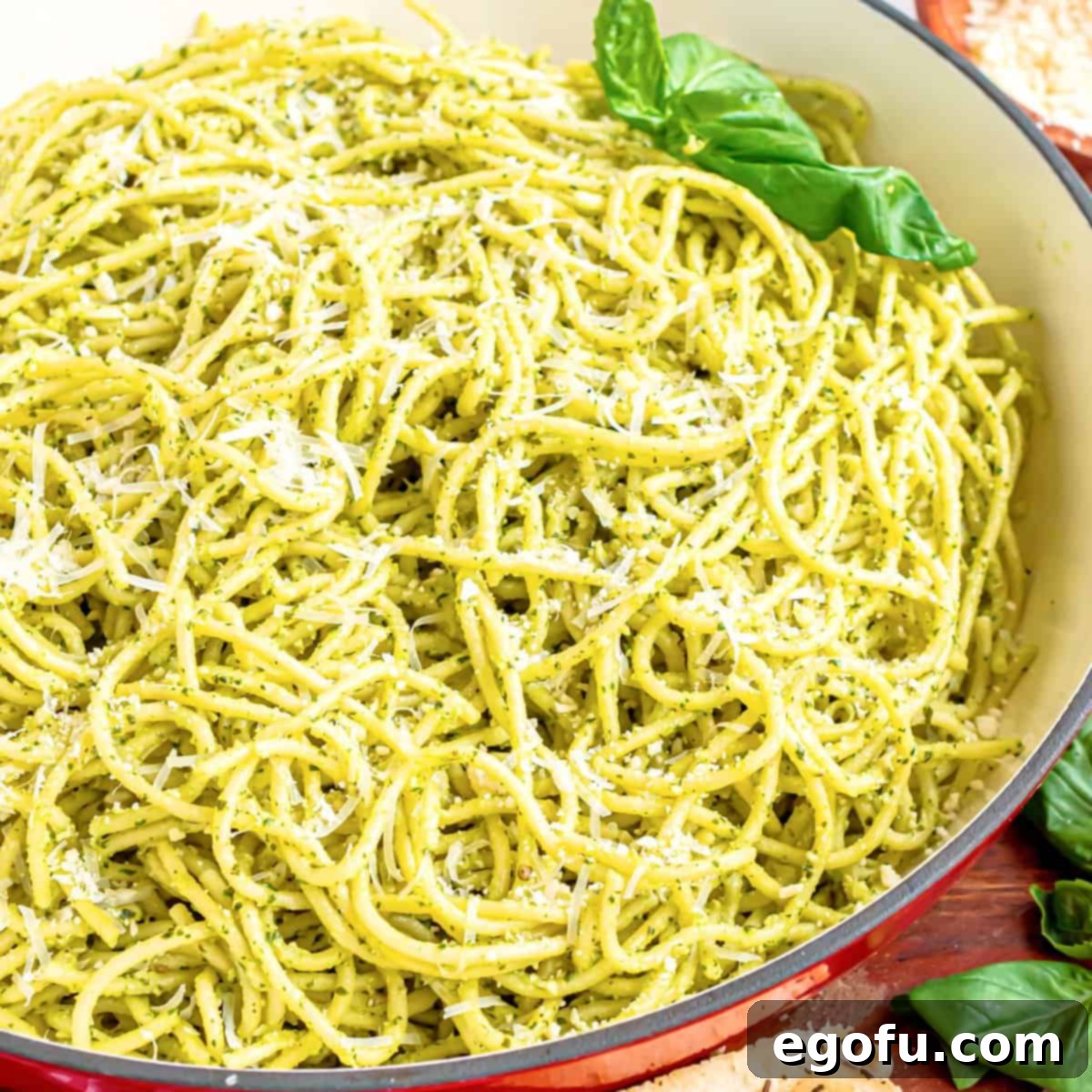Welcome to the ultimate guide for crafting the most incredibly easy and flavorful Pesto Pasta you’ve ever tasted! This dish, a celebration of fresh ingredients and vibrant flavors, is guaranteed to become a staple in your kitchen. Imagine a homemade basil pesto, bursting with aromatic herbs, rich cheese, and nutty undertones, perfectly coating your favorite pasta. This isn’t just a meal; it’s an experience that comes together in mere minutes, proving that gourmet taste doesn’t require hours in the kitchen.
Whether you’re a busy weeknight warrior searching for a quick yet satisfying dinner, a meal prepper looking for delicious leftovers, or simply craving the irresistible taste of classic Italian-inspired cuisine, this pesto pasta recipe is your answer. Forget bland, store-bought sauces; we’re diving into the world of fresh, bright, and utterly delicious homemade pesto that elevates simple pasta into a culinary masterpiece. Get ready to impress yourself and your loved ones with a dish that’s both comforting and incredibly fresh!
Mastering Homemade Pesto Pasta: A Quick & Flavorful Meal
There’s something truly magical about a well-made pesto pasta. It’s a dish that embodies simplicity and sophistication simultaneously. The secret, as you might guess, lies in the pesto itself. While store-bought options can suffice, nothing compares to the vibrant flavor and freshness of a homemade basil pesto. If you’ve never made your own, prepare for a revelation! It’s astonishingly easy, requiring just a few fresh ingredients and a food processor or blender. The reward is a sauce that transforms ordinary pasta into an extraordinary dining experience.
This recipe isn’t just about deliciousness; it’s about efficiency. In the time it takes to boil water and cook pasta, you can whip up a batch of glorious pesto from scratch. This makes it an ideal choice for quick weeknight dinners, leisurely weekend lunches, or even a satisfying midnight snack. Its versatility also means it can be adapted to suit various dietary preferences or what you have on hand. Plus, it reheats beautifully, making it perfect for meal prepping throughout the week. Let’s embark on a journey to create a restaurant-quality pesto pasta right in your own kitchen.
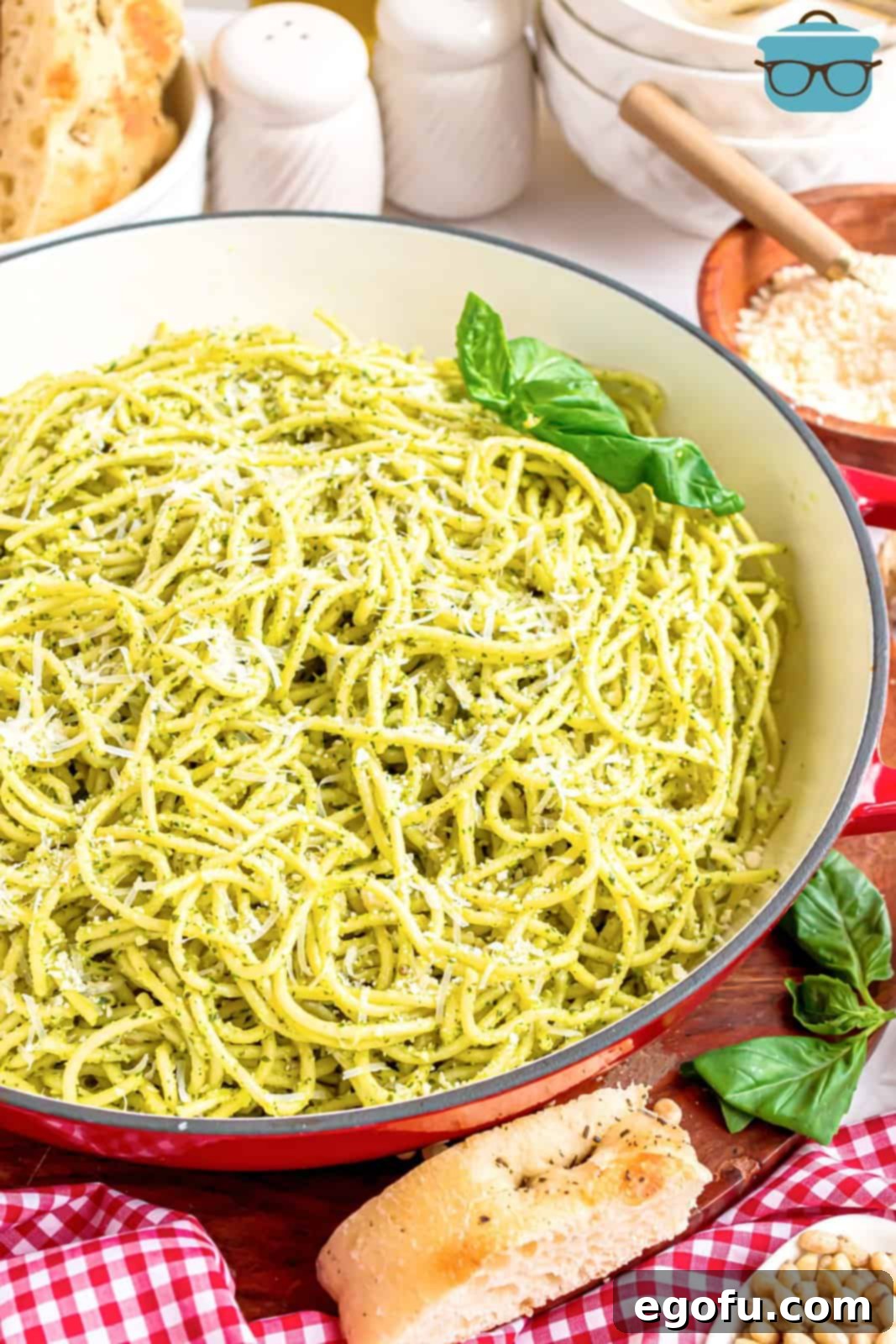
Frequently Asked Questions About Pesto Pasta
Here are some of the most common questions about making and enjoying this delightful pesto pasta, along with detailed answers to help you achieve perfection every time.
Absolutely! Adding chicken is a fantastic way to turn this vegetarian dish into a more substantial meal, perfect for satisfying even the heartiest appetites. You can use any type of pre-cooked chicken. Rotisserie chicken is an excellent shortcut, offering tender, seasoned meat that simply needs to be shredded or diced and folded into the pasta. Grilled chicken breast, pan-fried chicken tenders, or even leftover roasted chicken can also be used. For best results, add the chicken towards the end of the cooking process, allowing it to warm through and absorb some of the pesto’s incredible flavor without overcooking.
Pesto pasta, with its rich and aromatic profile, pairs wonderfully with several side dishes that complement its flavors without overpowering them. A classic choice is a nice, crusty bread or warm garlic breadsticks, perfect for soaking up any lingering pesto sauce. A fresh, crisp green salad, perhaps with a light vinaigrette, provides a refreshing contrast to the richness of the pasta. Other excellent accompaniments include roasted vegetables like cherry tomatoes, zucchini, or asparagus, which add texture and natural sweetness. A simple Caprese salad (tomatoes, fresh mozzarella, and basil) can also be a delightful pairing, echoing the basil notes in the pasta.
While spaghetti is often the most common choice and what you typically see pictured, the beauty of pesto pasta is its adaptability to various pasta shapes. Long, thin pasta like linguine, fettuccine, or even capellini (angel hair) works exceptionally well, as the silky pesto sauce clings beautifully to the strands. However, don’t hesitate to experiment with short pasta shapes too. Penne, rigatoni, fusilli, or farfalle (bow-tie pasta) are all excellent options, as their nooks and crannies, or twists and turns, capture and hold the pesto, ensuring every bite is packed with flavor. Ultimately, use whatever pasta you have on hand or what you enjoy most; the key is to ensure it’s cooked al dente.
No, the pine nuts are entirely optional and can be skipped if you prefer a nut-free version or simply don’t have them. While traditional pesto uses pine nuts for their distinct buttery flavor and creamy texture contribution, you can easily swap them out for other nuts like cashews, almonds, or walnuts if you’re looking for an alternative. Toasted nuts generally offer a deeper flavor profile. If avoiding nuts altogether, consider using sunflower seeds or pumpkin seeds for a similar texture, or simply omit them and increase the amount of cheese slightly. You can also experiment with the herb base by trading some of the fresh basil leaves for fresh spinach (about half) to create a milder, slightly sweeter pesto with a different nutritional boost.
Reserving some of the starchy pasta water is a crucial step that many professional chefs swear by. This cloudy water isn’t just for thinning the sauce; it’s a culinary secret weapon. The starch released from the pasta during cooking helps to emulsify the pesto sauce, making it incredibly creamy and luscious. It also helps the pesto coat the pasta strands more effectively, ensuring every bite is perfectly sauced. Adding a splash or two of this starchy water helps to bind the sauce to the pasta and achieve the ideal consistency, preventing the pesto from becoming too thick or oily.
Lemon juice plays a dual role in homemade pesto. Firstly, its acidity helps prevent the fresh basil from oxidizing and turning brown, maintaining that beautiful, vibrant green color we all associate with pesto. More importantly, lemon juice brightens up the overall flavor profile of the pesto. It cuts through the richness of the olive oil and cheese, adding a zesty tang that elevates the fresh basil notes and creates a more balanced, lively sauce. Always opt for fresh lemon juice over bottled varieties, as the latter can sometimes impart an artificial or metallic taste that detracts from the pesto’s natural freshness.
Leftover pesto pasta can be stored in an airtight container in the refrigerator for up to 5 days. Ensure it’s completely cooled before sealing it to prevent condensation, which can make the pasta soggy. While convenient, it’s generally not recommended to freeze pesto pasta. The texture of the pasta can become mushy, and the delicate fresh flavors of the pesto can diminish or change upon thawing, resulting in a less enjoyable experience. For best quality, always enjoy within the refrigerated timeframe.
The best way to reheat pesto pasta to preserve its texture and flavor is gently. Place the pasta in a covered, microwave-safe dish and microwave it in 30-second intervals. After each interval, stir the pasta thoroughly to distribute the heat evenly. Continue this process until the pasta is warmed through. If you notice the pasta starting to dry out, drizzle in a tiny bit of olive oil or a splash of water (or even more reserved pasta water if you saved it!) to bring back its moisture and lusciousness. Avoid overheating, as this can make the pasta rubbery and diminish the fresh pesto flavor.
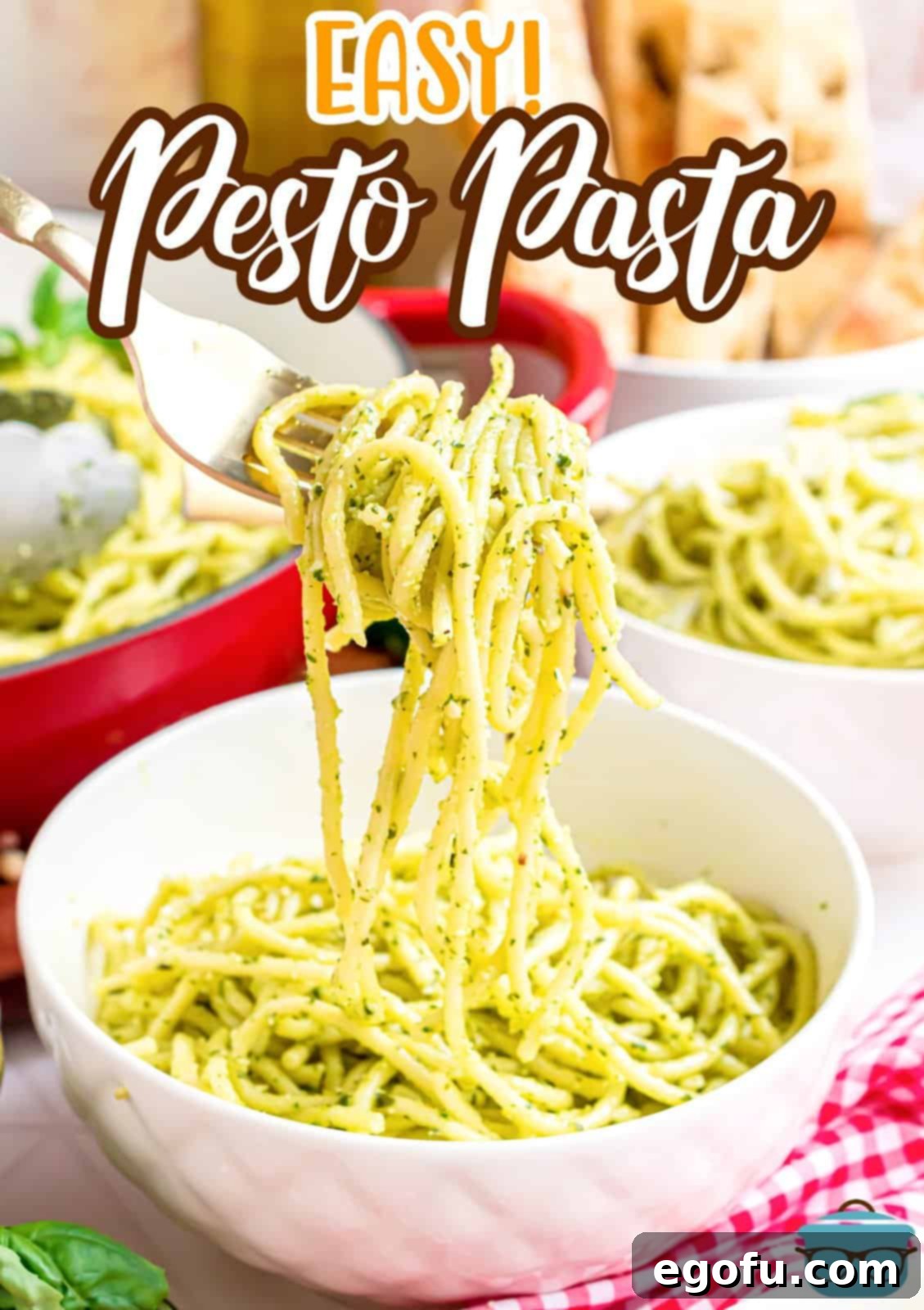
Essential Ingredients for Homemade Pesto Pasta
Crafting exceptional pesto pasta begins with selecting the right ingredients. Each component plays a vital role in building the layers of flavor that make this dish so irresistible. Here’s a closer look at what you’ll need and why each choice matters:
- Kosher Salt: More than just a seasoning, kosher salt is crucial for boiling your pasta. Generously salting the pasta water ensures that the noodles absorb flavor from the inside out, making them delicious on their own. If kosher salt isn’t available, regular table salt works too, but remember that kosher salt is less dense, so you might use slightly less by volume.
- Your Favorite Pasta: While spaghetti is a classic choice and excellent for catching the vibrant pesto sauce, feel free to use any pasta shape you love. Linguine, fettuccine, penne, or fusilli are all fantastic alternatives. The key is to choose a pasta that can hold the sauce well, ensuring every bite is full of flavor.
- Fresh Basil Leaves (Packed): This is the star of your pesto! Using fresh, vibrant basil is non-negotiable for an authentic and aromatic sauce. Look for bright green leaves without any wilting or black spots. The fresher the basil, the more intense and delicious your pesto will be.
- Fresh Garlic Cloves: While jarred minced garlic can be convenient for some dishes, fresh garlic is essential for the bright, pungent flavor that defines good pesto. Aim for 2-3 large cloves, quartered to help with processing. The raw garlic contributes a beautiful zing that cooked garlic simply can’t replicate.
- Toasted Pine Nuts: These small, buttery nuts add a delicate nutty flavor and a lovely richness to the pesto. Toasting them lightly in a dry pan before adding them to the food processor enhances their flavor significantly. If you’re out of pine nuts, or prefer an alternative, walnuts, cashews, or almonds can be great substitutes. For a nut-free version, sunflower seeds or pumpkin seeds are good options.
- Fresh Lemon Juice: As discussed in the FAQs, fresh lemon juice is a secret weapon. It prevents basil oxidation, keeping your pesto a beautiful green, and brightens the overall flavor profile. Always use freshly squeezed lemon juice; bottled varieties often contain preservatives that can impart an off-flavor.
- Grated Parmesan and Pecorino Romano Cheeses: The combination of these two Italian hard cheeses creates a complex, savory depth in your pesto. Parmesan offers a rich, nutty flavor, while Pecorino Romano adds a sharper, saltier kick. For the best flavor and texture, grate them fresh from a block. If Pecorino Romano isn’t available, using all Parmesan will still yield a delicious result.
- High-Quality Olive Oil: Olive oil is the base that brings all the pesto ingredients together. Extra virgin olive oil offers the most robust flavor, but a good quality light-flavored olive oil is also perfectly acceptable. Choose an oil with a flavor you enjoy, as it will be noticeable in the final sauce.
- Freshly Ground Black Pepper: A touch of freshly ground black pepper adds a subtle warmth and aromatic complexity, balancing the bright and savory notes of the pesto.
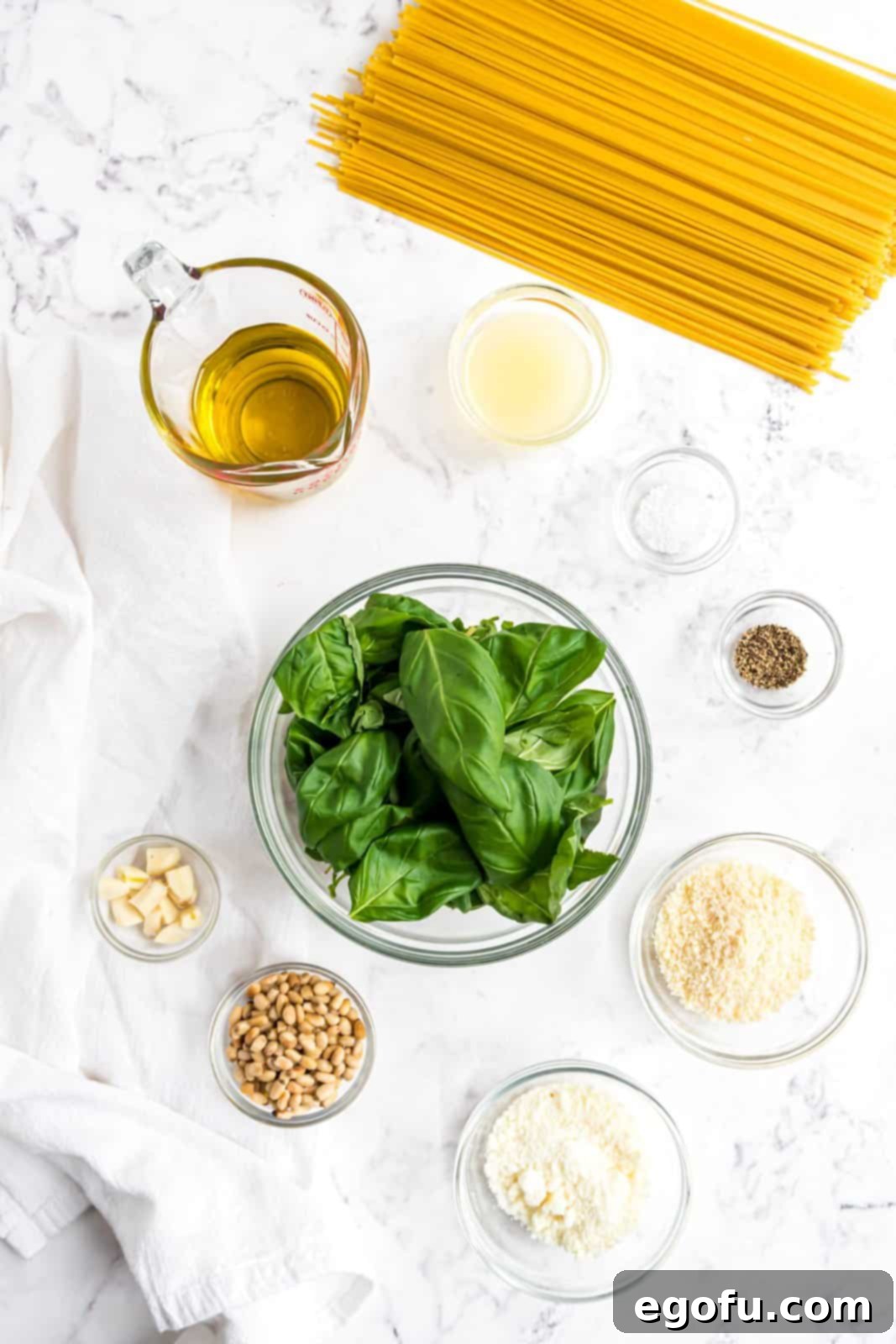
Step-by-Step: How to Make Perfect Pesto Pasta
Creating this flavorful pesto pasta is a straightforward process that yields impressive results. Follow these simple steps to bring this vibrant dish to life:
- Cook the Pasta: Begin by bringing a large pot of water to a rolling boil. It’s crucial to use a generously sized pot to allow the pasta to cook evenly. Once boiling, add a tablespoon of kosher salt to the water; this seasons the pasta from within. Add your chosen pasta (spaghetti is a great option) and cook it according to the package directions until it’s al dente – tender but still firm to the bite. Before draining the pasta, make sure to reserve about ½ cup of the starchy cooking water. This liquid is essential for achieving the perfect pesto sauce consistency. Once reserved, drain the remaining water from the pasta thoroughly.
- Prepare the Pesto Base: While your pasta water is heating up, you can start on the star of the show: the homemade pesto. In a blender or a mini-food processor, combine the fresh basil leaves (packed), quartered fresh garlic cloves, toasted pine nuts, 1 teaspoon of kosher salt, and ½ teaspoon of black pepper. Pulse the mixture in short bursts, about 10-15 times, until the ingredients are roughly chopped. Avoid over-processing at this stage, as you want to build the pesto in layers.
- Finish the Pesto: Next, add the fresh lemon juice, grated Parmesan cheese, grated Pecorino Romano cheese, and ½ cup of olive oil to the blender or food processor. Continue blending everything together until the mixture is well combined and forms a smooth, vibrant green sauce. Scrape down the sides of the processor as needed to ensure all ingredients are incorporated. Once smooth, set the fresh pesto aside.
- Combine Pasta and Pesto: Add the freshly made pesto directly to the cooked and drained pasta in the large pot (or a spacious serving bowl). Use tongs to gently toss the noodles, ensuring they are evenly coated with the rich green sauce. If you find the pesto sauce is too thick or doesn’t coat the noodles as smoothly as you’d like, gradually add the reserved pasta water, one tablespoon at a time, while continuing to toss. This starchy water will help thin the sauce to your desired consistency and make it cling beautifully to every strand of pasta.
- Serve and Enjoy: Once the pasta is perfectly coated in the luscious pesto, it’s ready to be served. For an extra touch of elegance and flavor, top the pesto pasta with additional grated or shaved Parmesan cheese before serving. A sprig of fresh basil can also make for a lovely garnish. Serve immediately and savor the incredible freshness and simplicity of this delightful dish!
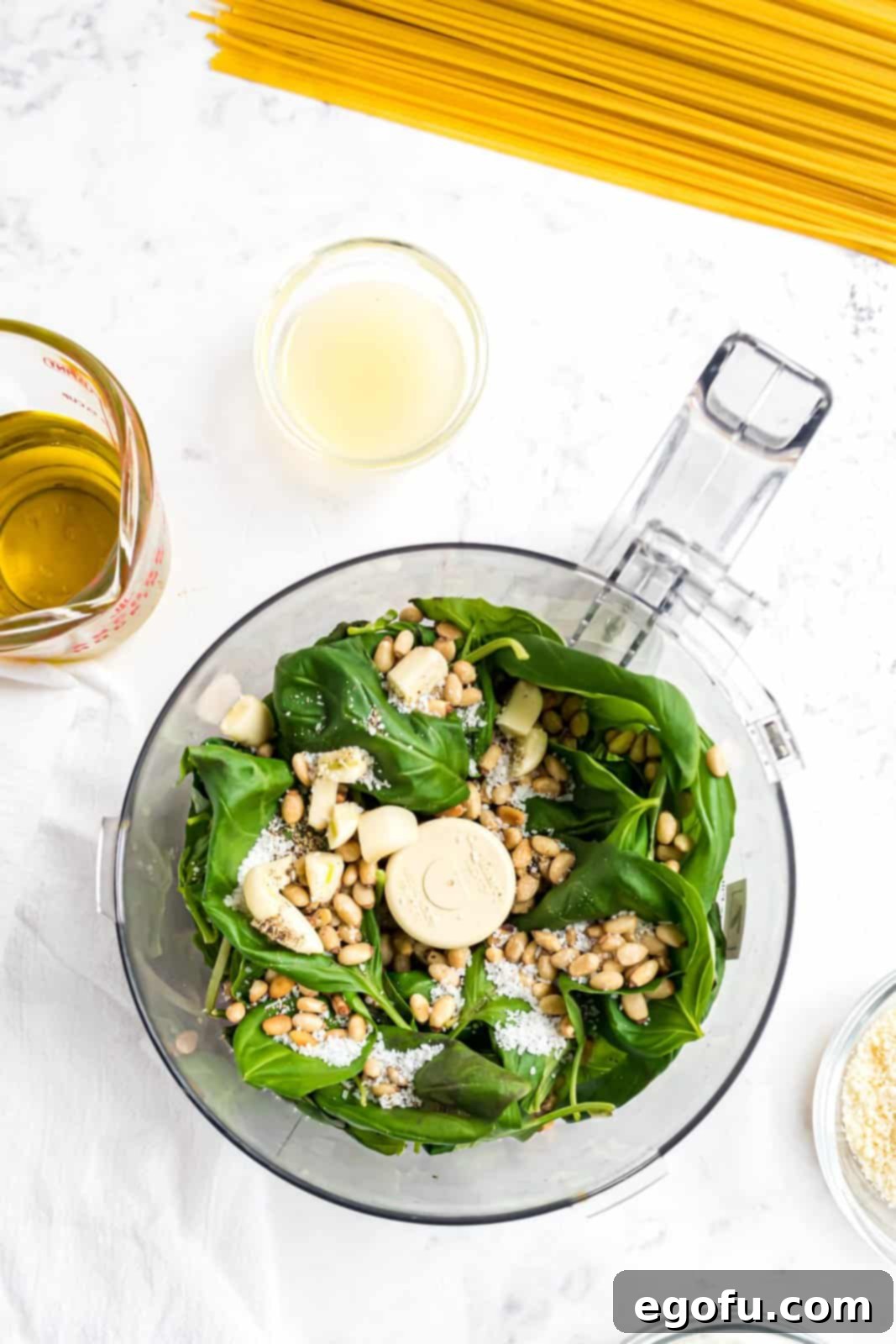
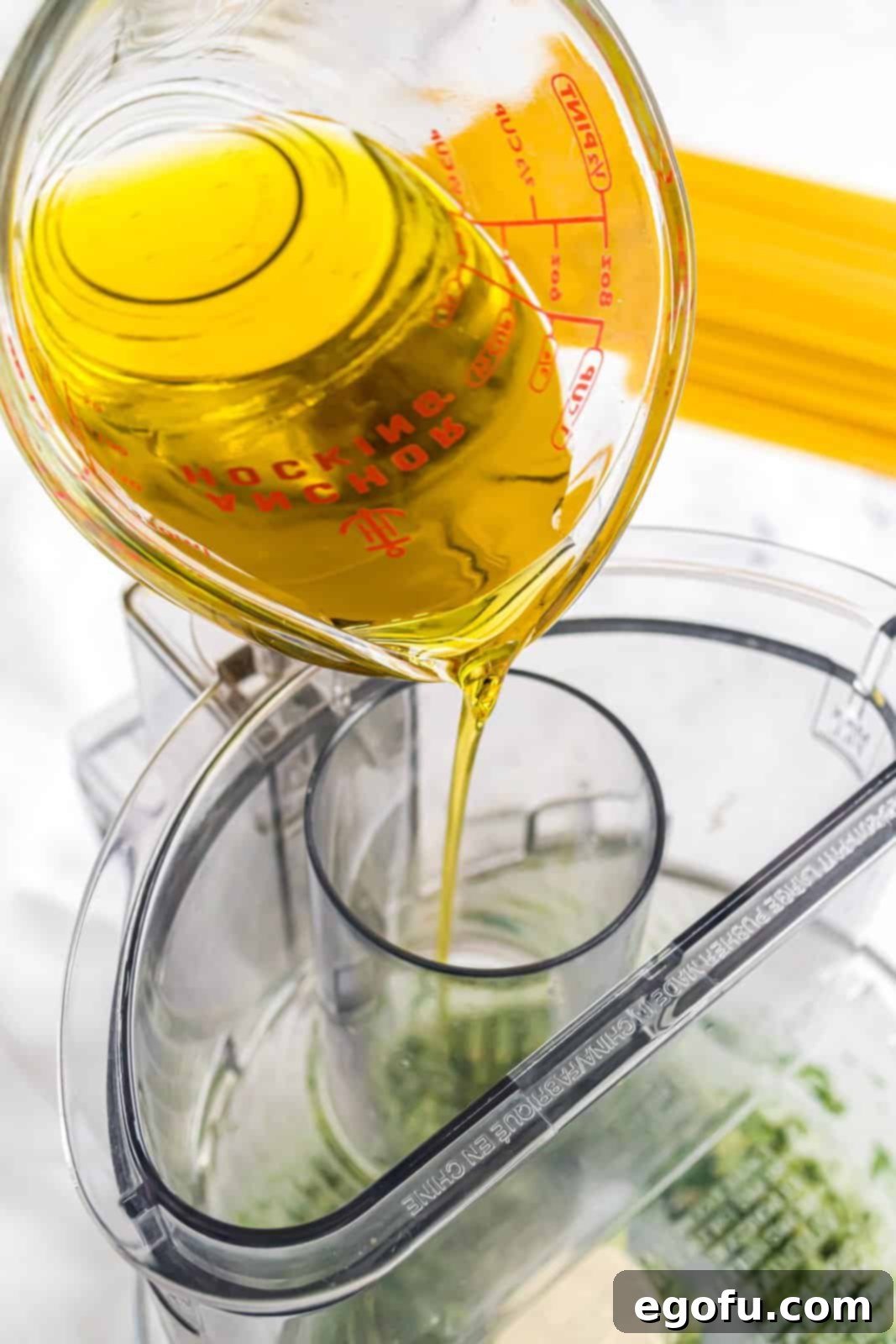
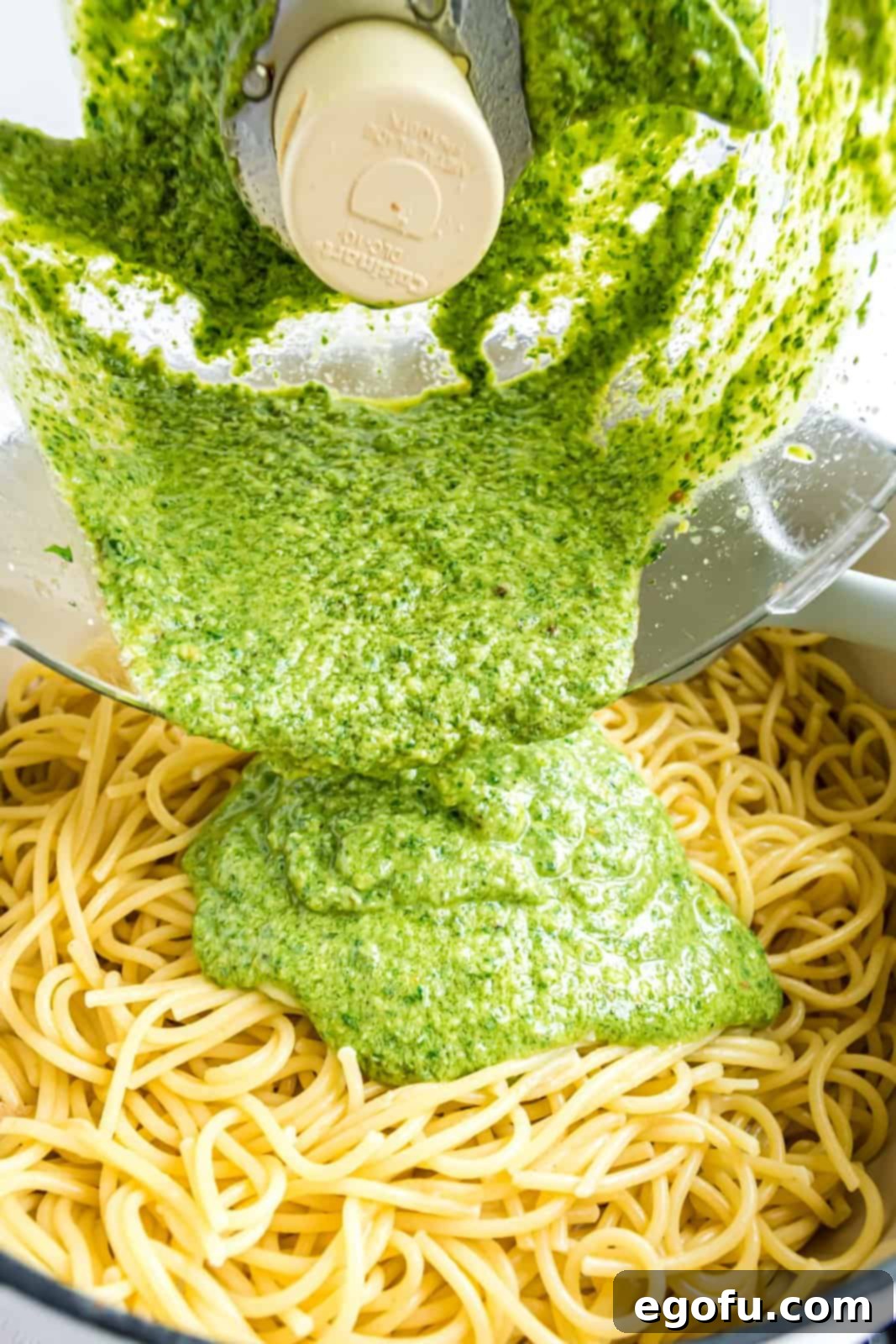

Tips for Perfect Pesto Every Time
While making pesto pasta is incredibly simple, a few expert tips can elevate your dish from good to extraordinary:
- Use Fresh, Quality Ingredients: This is paramount for pesto. Fresh basil, quality olive oil, and freshly grated cheeses make a noticeable difference in flavor.
- Don’t Over-Process the Pesto: Pulse, don’t blend continuously. Over-processing can generate heat, which can “cook” the basil and cause it to lose its vibrant green color and fresh flavor, resulting in a slightly bitter, dull pesto.
- Taste and Adjust: Always taste your pesto before mixing it with pasta. Adjust salt, pepper, or lemon juice to your preference. Remember, the pasta water will also add some saltiness.
- Warm Your Serving Bowl: To keep your pasta warm longer, especially if it’s a cooler day, briefly warm your serving bowl with hot water before adding the pasta.
- Add Protein for a Complete Meal: As mentioned, chicken, shrimp, or even some cannellini beans can turn this into a more robust and protein-packed meal.
Customizing Your Pesto Pasta: Variations & Add-ins
The beauty of pesto pasta lies in its versatility. Feel free to get creative and tailor it to your taste or what you have on hand:
- Vegetable Boost: Stir in blanched green beans, roasted cherry tomatoes, sautéed zucchini, or steamed broccoli florets for added nutrients and texture.
- Spice It Up: A pinch of red pepper flakes can add a subtle kick that complements the pesto beautifully.
- Different Cheeses: Experiment with other hard cheeses like Asiago or even a sprinkle of crumbled feta for a Mediterranean twist.
- Herb Variations: While basil is traditional, you can also make pesto with a mix of herbs like parsley, cilantro (for a more Mexican-inspired flavor), or even arugula for a peppery note.
- Vegan Option: For a delicious vegan pesto, simply omit the Parmesan and Pecorino Romano and replace them with nutritional yeast for a cheesy flavor, or a plant-based grated cheese alternative.
Serving Suggestions for Pesto Pasta
While pesto pasta is a delicious standalone meal, pairing it with complementary dishes can elevate your dining experience:
- Garlic Bread or Focaccia: Perfect for soaking up the luscious pesto.
- Simple Green Salad: A light, crisp salad with a basic vinaigrette provides a refreshing contrast.
- Roasted Vegetables: Asparagus, bell peppers, or cherry tomatoes roasted with a drizzle of olive oil are excellent sides.
- Grilled Protein: Serve alongside grilled chicken, fish, or halloumi cheese for a balanced meal.
Storing and Reheating Leftover Pesto Pasta
Leftovers are a joy with this dish! Store any remaining pesto pasta in an airtight container in the refrigerator for up to 5 days. For reheating, the best method is to gently warm it in a microwave. Place the pasta in a covered, microwave-safe dish and heat in 30-second intervals, stirring between each. If the pasta seems a little dry, add a splash of olive oil or water to restore its moisture and texture. Avoid freezing, as it can compromise the pasta’s texture and the pesto’s fresh flavor.
Expand Your Culinary Repertoire: More Delicious Recipes
If you’ve fallen in love with the vibrant flavors of this pesto pasta, explore these other fantastic recipes that celebrate fresh ingredients and comforting pasta dishes:
- Grilled Chicken Pesto Pasta
- Caesar Basil Pasta Salad
- Tuscan Chicken Pasta
- Lamb Chops with Mint Pesto
- Easy Tomato Basil Sauce
- Tortellini Carbonara
- Orzo Pasta Salad
- Marry Me Chicken Pasta

Pesto Pasta
Pin Recipe
10 minutes
15 minutes
25 minutes
6 servings
Brandie Skibinski
Ingredients
- 1 Tablespoon kosher salt for boiling water
- 1 pound of spaghetti
- 2 cups fresh basil leaves packed
- 2-3 cloves garlic cut into quarters
- ¼ cup toasted pine nuts
- 1 teaspoon kosher salt
- ½ teaspoon black pepper
- 2 Tablespoons fresh lemon juice the juice from 1 large lemon
- ¼ cup grated Parmesan cheese
- ¼ cup grated Pecorino Romano cheese
- ½ cup olive oil
- grated or shaved parmesan for garnish
Instructions
- Start by bringing a large pot of water to a boil. Once it is boiling add a Tablespoon of kosher salt. Add the pasta and cook it according to the package instructions. Before draining the pasta, make sure to reserve about ½ cup of water from the pot. Drain the rest of the liquid from the pasta.
- While the water is heating up, combine fresh basil, garlic, pine nuts, salt, and pepper in a blender or mini-food processor. Pulse the mixture about 10-15 times until the ingredients are roughly chopped.
- Next, add lemon juice, cheese, and olive oil to the blender or food processor with the basil mixture. Blend everything together until it is well combined, and then set it aside.
- Add the pesto to the cooked pasta and toss to coat the noodles evenly. If the pesto is too thick, add the reserved pasta water, a little at a time, to thin the sauce until all the noodles are covered in pesto.
- Finally, top the pesto pasta with grated or shaved parmesan cheese before serving. Enjoy!
Notes
- Please refer to my FAQs and ingredient list above for other substitutions or for the answers to the most common questions.
- You can add any protein to this dish to round it out. Cooked chicken, shrimp, or even pork would be good.
- Feel free to trade out the pine nuts for other nut choices or ditch them altogether.
- You can use spaghetti or other pasta like linguini or fettuccini.
- If you want less basil, you can swap half the basil out for fresh spinach.
- Lemon juice helps give some yummy flavor to the pesto and helps the pesto to stay a beautiful shade of green.
- Using the reserved pasta water helps the sauce stick to the pasta easier.
- Leftovers can be stored in the fridge in a container for up to 5 days. I don’t recommend trying to freeze leftovers and using the microwave in 30-second bursts is the best way to reheat leftovers.
Main Course
American
Nutrition
Carbohydrates: 59 g |
Protein: 14 g |
Fat: 25 g |
Sodium: 1679 mg |
Fiber: 3 g |
Sugar: 2 g
Nutritional Disclaimer
“The Country Cook” is not a dietician or nutritionist, and any nutritional information shared is an estimate. If calorie count and other nutritional values are important to you, we recommend running the ingredients through whichever online nutritional calculator you prefer. Calories and other nutritional values can vary quite a bit depending on which brands were used.
Did you make this recipe?
Share it on Instagram @thecountrycook and mention us #thecountrycook!
With its vibrant flavors, simple preparation, and incredible versatility, pesto pasta truly is a culinary delight that belongs in every home cook’s repertoire. From the first aromatic whiff of fresh basil to the last satisfying bite, this dish promises a wholesome and delicious experience. We hope this comprehensive guide inspires you to whip up your own batch of homemade pesto pasta and discover the joy of creating restaurant-quality meals in minutes. Happy cooking!
